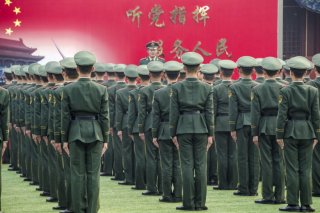This Country Should Fear China's Rising Military (And It's Not America)
In 2013 alone, China's Navy laid down, commissioned or launched more than 60 surface vessels, considerably more than Australia's entire naval fleet.
Last week, China's State Council released a new White Paper on Military Strategy. Although somewhat overshadowed by heightened tensions in the South China, the document has deep long-term implications for Australian defense. For the first time since World War II, a regional state is officially developing the full suite of conventional military capabilities, and now also the doctrine, to pose a direct threat to Australia and its vital interests. This is a big change.
For more than seventy years, the defining feature of Australia's strategic environment has been the absence of a threat against which to plan its defense. It's been a good problem to have, and one that many countries would be only too happy to trade for their more exacting circumstances. But such a benign environment has also made things tricky when it comes to discerning what kind of military forces to build.
The 1987 Defense White Paper offered a clever solution: build a flexible force comprised of different military capabilities; keep a close watch on regional strategic developments, including the lead times on military capabilities and doctrines that could potentially threaten Australia; and if and when a more clear threat emerges, expand the existing force to meet the challenge.
(Recommended: Why Australia Must Stay Out of the South China Sea Showdown)
Unfortunately, however, the White Paper didn't quite go all the way. What it failed to offer, at least publicly, was a concrete set of criteria by which the threat could be identified and the expansion process activated. The assumption regarding emerging threats seems to have been roughly in line with Justice Potter's famous test for obscenity: “we'll know it when we see it.”
Today, as a basis for defense planning, that threat is finally materializing in the form of China's blue-water navy. In particular, China's new White Paper outlines a naval strategy that formally expands the role of China's air and maritime forces. The PLA, it notes, “will gradually shift its focus from 'offshore waters defense' to the combination of 'offshore waters defense' with 'open seas protection.'”
This is more than a semantic difference or change in nomenclature. Nor does it simply expand the range of the existing anti-access/area-denial (A2AD) strategy, which remains strategically defensive and hence little threat to Australia. Rather, 'open-seas protection' represents a paradigmatic shift: the first formal, national-level policy endorsement of a blue-water navy and the sea-control missions it implies.
(Recommended: Averting a Deepening U.S.-China Rift Over the South China Sea)
'Open-seas protection', if it's to be realized, will mean sustained budgetary increases for the PLA Navy; continued investment in ocean-going capabilities, namely major surface combatants and their logistical support vessels; an operational focus on controlling and using distant seas for military purposes (rather than just having the ability to deny such control to others); and ultimately, a more expansive strategic and geopolitical vision for China in the region and the world.
What makes the announcement all the more compelling is that it is already underway. Only fifteen years ago, China's surface navy was a motley fleet of a few dozen warships at various stages of obsolescence. Since then, a comprehensive modernization effort, beginning fitfully but accelerating rapidly over the last decade, has propelled it on to the front ranks of naval power. In 2013 alone, China's Navy laid down, commissioned or launched more than 60 surface vessels, considerably more (ignoring type) than Australia's entire naval fleet.
One aircraft carrier has been delivered and more are on the way. China has also commenced serial production of cruisers, destroyers, frigates and corvettes. Many of these, to be sure, are largely confined to China's 'green-water', and as such would be unsuitable for use against Australia. But an increasing number of bigger, more advanced warships are also coming on line, and these do not face the same constraints. As the US Office of Naval Intelligence notes, “(T)he addition of these new units allows the PLA(N) surface force to operate with increased confidence outside of shore-based air defense systems, as one or two ships are equipped to provide air defense for the entire task group”.
None of this is to suggest that China's blue-water navy will ever be directed against Australia — only that it eventually could be, and that this portends a major change in Australia's strategic circumstances. Prudent defense planning need to be done on the basis of capabilities, not intentions.
(Recommended: Taiwan Can't Save the South China Sea)
The challenge now for Australian defense planners is to transform the ADF into a ship-killing A2AD force, beginning with a comprehensive study of the threat and the capability sets needed to meet it. On this front there's good and bad news.
The good news is that an effective template for this kind of approach already exists, ironically, in China's own efforts to offset the threat posed by the US blue-water fleet. Australia could do much worse than to emulate this approach and adapt it to our own circumstances. The bad news is that trends in Australia's naval force structure appear to be moving in exactly the opposite direction.
This piece first appeared in the Lowy Interpreter here.
Image: Creative Commons License.

